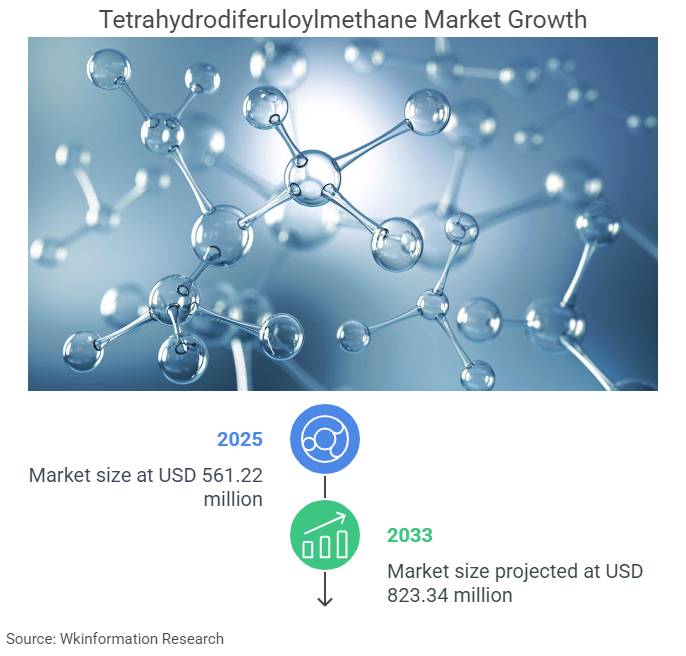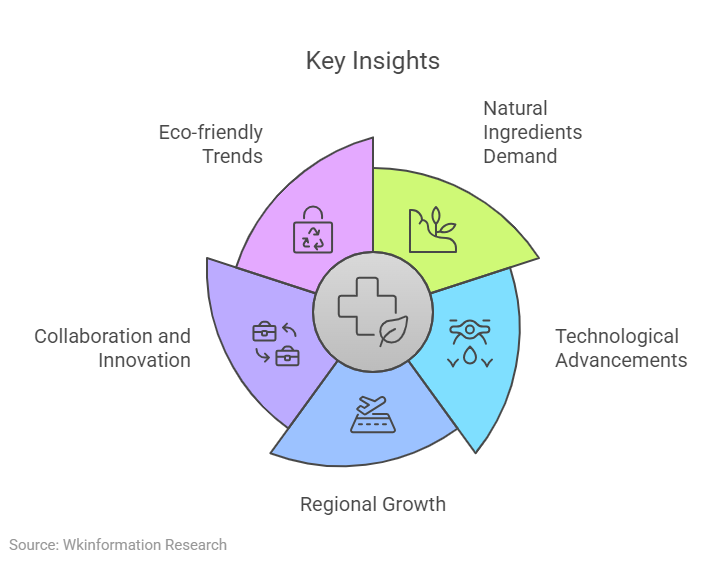
The Tetrahydrodiferuloylmethane market revolves around the production and application of this compound, which is known for its potent antioxidant, anti-inflammatory, and potential neuroprotective properties. It is widely utilized in the pharmaceutical, cosmetic, and nutraceutical industries, where it serves as an active ingredient in formulations aimed at promoting skin health, reducing inflammation, and supporting cognitive function. The market’s growth is fueled by increasing consumer demand for natural and plant-based products, as well as advancements in research highlighting its therapeutic potential. The market size will reach USD 561.22 million in 2025 and is expected to reach USD 823.34 million by 2033, with a CAGR of 4.91% from 2025 to 2033. With rising health awareness and technological innovations in extraction methods, the market is poised for continued expansion.
Key Insights
- The tetrahydrodiferuloylmethane market is growing fast because more people want natural ingredients.
- Better technology is helping make production quicker and products better, so tetrahydrodiferuloylmethane is easier to get.
- Asia-Pacific is the fastest-growing area due to health awareness and growing economies.
- Companies need partnerships and teamwork to create new ideas and handle challenges well.
- Eco-friendly trends matter since buyers like green products, helping businesses that focus on natural items.

Market Overview
Current Market Size and Value
The tetrahydrodiferuloylmethane market has witnessed steady growth in recent years, driven by increasing consumer demand for natural and organic functional ingredients. This growth aligns with rising health trends and the global shift toward wellness-focused products. The market’s current valuation reflects its expanding applications across industries such as pharmaceuticals, cosmetics, and food and beverages. Analysts project continued growth through 2025, as personalization and innovation in product offerings gain momentum.
Key Players and Competitive Landscape
The competitive landscape of the tetrahydrodiferuloylmethane market is highly dynamic. It features a mix of established companies and emerging players. Leading firms include:
- Sabinsa Corporation
- Hangzhou Rebtech Novel Material
- BioOrganic Concepts
The market remains fragmented, with larger companies pursuing acquisitions to expand their portfolios and achieve economies of scale. Strategic partnerships have become a common trend, enabling firms to combine expertise and drive innovation. Despite intense competition, opportunities exist for new entrants offering unique value propositions or targeting underserved niches.
Product Segmentation in the Tetrahydrodiferuloylmethane Market
By Type
The Tetrahydrodiferuloylmethane market is segmented into powder, liquid, and capsule forms. Each type caters to different consumer preferences and application needs. Powder form is often favored for its versatility and ease of use in various formulations. Liquid form is commonly used for its faster absorption and convenience in beverages or topical applications. Capsules are preferred for their ease of consumption and precise dosage, making them popular in dietary supplements and pharmaceuticals. These segments contribute to the overall market growth, addressing distinct consumer demands.
By Application
The Tetrahydrodiferuloylmethane market is divided into cosmetics, personal care products, and other applications. In cosmetics, it is valued for its antioxidant and anti-inflammatory properties, promoting skin health and reducing signs of aging. Personal care products benefit from its inclusion in formulations targeting skin care, hair care, and overall wellness. The “other” category includes applications in dietary supplements and pharmaceuticals, where it is used for its potential therapeutic effects. These diverse applications help drive market growth by catering to the expanding consumer demand for natural and functional ingredients.
Regional Market Distribution
North America
North America leads the tetrahydrodiferuloylmethane market due to its advanced technological infrastructure and significant investments in research and development. The region benefits from high adoption rates of innovative products, driven by evolving consumer preferences for high-quality functional ingredients. Key factors contributing to growth include:
- Technological advancements that enhance product efficiency.
- Rising consumer demand for organic and wellness-focused products.
- Regulatory support encouraging investment in sustainable technologies.
- Increased industrialization, boosting demand across multiple sectors.
The region’s strong focus on health trends and wellness ensures its dominance in the market through 2025. Companies in North America continue to expand globally, leveraging their technological edge to capture emerging opportunities.
Europe
Europe exhibits steady growth in the tetrahydrodiferuloylmethane market, supported by stringent regulations and growing awareness of health benefits. Technological advancements in production processes have further strengthened the region’s position. European consumers prioritize organic and sustainable ingredients, aligning with the region’s broader environmental goals. This trend has encouraged manufacturers to innovate and meet the demand for high-purity functional ingredients. The market’s growth in Europe reflects its commitment to quality and sustainability.
Asia-Pacific
Asia-Pacific represents the fastest-growing region in the tetrahydrodiferuloylmethane market. Expanding economies and rapid industrialization drive demand for functional ingredients across various industries. The region’s rising middle class and increasing consumer awareness of health trends contribute to this growth. Countries like China and India play a pivotal role, with their robust manufacturing capabilities and growing pharmaceutical and cosmetic sectors. Asia-Pacific’s dynamic market environment offers significant opportunities for stakeholders aiming to capitalize on emerging trends.
Rest of the World
The Rest of the World, including Latin America, the Middle East, and Africa, shows promising growth potential. Economic development and rising consumer demand for wellness-focused products fuel market expansion in these regions. Latin America benefits from increasing industrialization and a growing focus on health-conscious consumers. Meanwhile, the Middle East and Africa experience growth due to government initiatives promoting technological advancements and industrial diversification. These regions present untapped opportunities for companies seeking to expand their global footprint.
| Region | Key Characteristics |
|---|---|
| North America | Dominates the market due to advanced technology, high adoption rates, and significant R&D investments. |
| Europe | Exhibits growth supported by regulations, awareness, and technological advancements. |
| Asia-Pacific | Rapidly growing due to expanding economies and rising industrialization. |
| Latin America | Promising growth potential fueled by economic development and consumer demand. |
| Middle East and Africa | Expanding due to industrialization and government focus on technology advancement. |
Key Trends Shaping the Tetrahydrodiferuloylmethane Market

Rising Demand for Natural and Sustainable Ingredients
The tetrahydrodiferuloylmethane market is witnessing a surge in demand for natural and sustainable ingredients. Consumers increasingly prioritize health and wellness, driving the shift toward organic and functional ingredients. This trend aligns with the growing awareness of the health benefits associated with tetrahydrodiferuloylmethane, particularly its antioxidant properties. The compound’s use in skincare products has also gained momentum, reflecting the broader preference for natural alternatives to synthetic additives. Additionally, the rising demand for natural antioxidants underscores the market’s alignment with evolving health trends and consumer preferences for wellness-focused products.
Technological Innovations in Production
Advancements in production technologies have significantly influenced the growth of the tetrahydrodiferuloylmethane market. Manufacturers are adopting innovative methods to enhance the efficiency and purity of this functional ingredient. These innovations not only improve product quality but also reduce production costs, making tetrahydrodiferuloylmethane more accessible across industries. The integration of cutting-edge technologies ensures that the market remains competitive while meeting the increasing demand for high-quality, sustainable ingredients. As a result, technological progress continues to shape the market’s trajectory toward 2025.
Increasing Applications Across Industries
Pharmaceutical Applications
The pharmaceutical sector represents a key driver of growth for the tetrahydrodiferuloylmethane market. This compound, known for its potent antioxidant and anti-inflammatory properties, is widely used in health supplements and therapeutic formulations. Its bioactive properties, including anti-cancer potential, make it valuable for managing chronic diseases and improving overall well-being. These applications highlight the compound’s versatility and its critical role in advancing health and wellness.
Cosmetic and Personal Care Applications
Tetrahydrodiferuloylmethane has become a sought-after ingredient in the cosmetics industry due to its natural antioxidant properties. It is particularly effective in anti-aging formulations, where it helps neutralize free radicals and reduce oxidative stress. The compound enhances skin elasticity and minimizes wrinkles, making it a preferred choice for personal care products. This trend reflects the growing consumer demand for organic and functional ingredients in skincare.
Food and Beverage Applications
In the food and beverage sector, tetrahydrodiferuloylmethane is gaining traction as a natural additive. Its antioxidant properties contribute to product preservation and enhance nutritional value. The compound’s ability to align with health trends and consumer preferences for organic ingredients positions it as a valuable component in functional food products. This application underscores its versatility and expanding role across industries.
Regional Growth Trends
Emerging Markets in Asia-Pacific
The Asia-Pacific region has emerged as a significant driver of growth in the tetrahydrodiferuloylmethane market. Rapid industrialization and expanding consumer markets have created a fertile ground for the adoption of functional ingredients. Increasing demand for natural and organic ingredients reflects the region’s alignment with global health trends. Consumers in countries like China and India are becoming more health-conscious, favoring plant-based and natural products that support wellness-oriented lifestyles. This shift has spurred the growth of industries such as pharmaceuticals, cosmetics, and food and beverages, which rely heavily on high-quality functional ingredients.
The region’s industrial expansion has also contributed to the market’s growth. Manufacturers are leveraging Asia-Pacific’s robust production capabilities to meet the rising demand for personalized and innovative products. The growing middle class in these countries further amplifies this trend, as disposable incomes increase and consumers prioritize health and wellness. These factors position Asia-Pacific as a key player in the global tetrahydrodiferuloylmethane market, with significant potential for continued growth through 2025.
Growth in Developed Economies
Developed economies, including North America and Europe, continue to play a pivotal role in the tetrahydrodiferuloylmethane market. North America leads the market due to its advanced technological infrastructure and high adoption rates of innovative products. The region’s focus on research and development has enabled manufacturers to produce high-purity functional ingredients efficiently. Consumers in North America increasingly demand organic and wellness-focused products, driving market growth.
Europe also exhibits steady growth, supported by government policies that encourage the use of sustainable and natural ingredients. The region’s commitment to quality and environmental sustainability aligns with consumer preferences for organic and functional products. Technological advancements in production processes have further strengthened Europe’s position in the market.
Both regions demonstrate a strong commitment to innovation and sustainability, ensuring their continued influence on the global tetrahydrodiferuloylmethane market. These developed economies set the benchmark for quality and efficiency, driving trends that resonate across the industry.
Growth Projections and Influencing Factors for 2025

Market Drivers
Growing Consumer Awareness of Health Benefits
The increasing awareness of Tetrahydrodiferuloylmethane’s health benefits significantly drives market growth. Known for its antioxidant, anti-inflammatory, and anti-cancer properties, this ingredient appeals to health-conscious consumers. Its ability to neutralize free radicals and reduce oxidative stress has made it a popular choice in anti-aging cosmetics and dietary supplements. These attributes align with global health trends, where consumers prioritize wellness and nutrition in their daily lives.
Expansion of End-Use Industries
The expansion of end-use industries, such as pharmaceuticals, cosmetics, and food and beverages, contributes to the market’s revenue growth. Rising demand for natural and organic functional ingredients across these sectors reflects evolving consumer preferences. The biopharma industry, in particular, benefits from the compound’s bioactive properties, which enhance therapeutic formulations. Additionally, the growing popularity of personalization in product offerings further accelerates the adoption of Tetrahydrodiferuloylmethane in diverse applications.
Market Challenges
High Production Costs
High production costs remain a significant challenge for the Tetrahydrodiferuloylmethane market. Limited availability of raw materials and the complexity of extraction processes contribute to these expenses. Manufacturers must invest in advanced technologies to optimize production efficiency and reduce costs, ensuring the ingredient remains accessible to a broader range of industries.
Regulatory and Compliance Issues
Regulatory and compliance challenges also impact market growth. Organizations such as the FDA and the European Medicines Agency enforce stringent standards for product safety and efficacy. Companies must navigate these regulations to ensure compliance, which can increase operational costs and delay product launches. Despite these hurdles, adherence to regulatory frameworks enhances consumer trust and supports long-term market sustainability.
Economic Indicators and Forecasts
Projected Market Size in 2025
The Tetrahydrodiferuloylmethane market is projected to achieve substantial growth by 2025, driven by rising demand for functional ingredients and expanding industrial applications. Emerging markets in Asia-Pacific and Latin America are expected to play a pivotal role in this expansion, supported by infrastructure development and increasing disposable incomes.
CAGR and Growth Rates
The market is anticipated to grow at a compound annual growth rate (CAGR) of 4.91% during the forecast period from 2025 to 2033. This robust growth reflects the industry’s alignment with biopharma trends and the global shift toward wellness-focused products. Technological advancements and government incentives further bolster the market’s upward trajectory, ensuring its relevance in the evolving landscape of health and nutrition.
Opportunities for Stakeholders in the Tetrahydrodiferuloylmethane Market
Investment Opportunities in Emerging Markets
Emerging markets present significant opportunities for stakeholders in the tetrahydrodiferuloylmethane market. Rapid industrialization and expanding consumer bases in regions like Asia-Pacific drive demand for functional ingredients. Companies are actively expanding their operations and distribution networks to cater to this growing demand. Favorable government policies further encourage investments in tetrahydrodiferuloylmethane technologies, creating a supportive environment for market growth. These markets offer a fertile ground for businesses seeking to capitalize on evolving trends and unmet consumer needs.
Key opportunities in emerging markets include:
- Establishing production facilities to leverage cost-effective manufacturing.
- Expanding distribution channels to reach underserved regions.
- Collaborating with local partners to navigate regulatory landscapes effectively.
By focusing on these areas, stakeholders can position themselves for long-term success in these high-potential regions.
Strategic Partnerships and Collaborations
Strategic partnerships play a pivotal role in driving innovation and market expansion. Companies are increasingly collaborating to pool resources, share expertise, and accelerate product development. These partnerships enable stakeholders to address challenges such as high production costs and regulatory compliance more effectively. Joint ventures with research institutions and technology providers also foster advancements in production processes, enhancing product quality and efficiency.
Collaborations with regional distributors and retailers further strengthen market presence. By aligning with local partners, companies can better understand consumer preferences and adapt their offerings accordingly. This approach not only boosts market penetration but also fosters trust and loyalty among consumers.
Focus on Research and Development
Research and development remain critical for advancing the tetrahydrodiferuloylmethane market. Companies investing in R&D gain a competitive edge by driving technological innovations that improve product capabilities and reduce costs. Enhanced efficiency in production processes allows manufacturers to meet the growing demand for high-quality functional ingredients. R&D efforts also enable the development of personalized products, aligning with consumer preferences for tailored solutions.
The focus on R&D supports the creation of sustainable and natural ingredients, addressing the increasing consumer demand for health-conscious products. By prioritizing innovation, stakeholders can unlock new opportunities and ensure their relevance in the market through 2025.
Leveraging Sustainability Trends
Sustainability trends have become a driving force in the tetrahydrodiferuloylmethane market. Consumers increasingly demand natural and eco-friendly products, prompting manufacturers to prioritize sustainable practices. This shift aligns with the rising popularity of natural and sustainable ingredients, which play a pivotal role in meeting consumer expectations for health-conscious and environmentally responsible solutions.
The use of tetrahydrodiferuloylmethane in skincare products exemplifies this trend. Its natural antioxidant properties make it a preferred choice for formulations that cater to wellness-focused consumers. These products not only address the growing demand for functional ingredients but also reflect the industry’s commitment to reducing environmental impact. By leveraging these trends, companies can enhance their brand reputation and attract a broader customer base.
Regulatory support further stimulates demand for sustainable solutions. Governments worldwide encourage the adoption of eco-friendly practices, creating opportunities for businesses to align with these policies. Technological advancements also contribute to this growth by improving production efficiency and reducing waste. These innovations enable manufacturers to meet sustainability goals while maintaining product quality and affordability.
The projected growth of the market through 2025 underscores the importance of sustainability. Companies that embrace these trends can unlock significant opportunities in emerging and developed markets. By focusing on sustainable practices, businesses can position themselves as leaders in the industry, driving both profitability and environmental stewardship.
Sustainability is no longer optional; it is a necessity. The integration of sustainable practices into the production and application of tetrahydrodiferuloylmethane ensures long-term growth and aligns with evolving consumer preferences. This approach not only benefits the environment but also creates a competitive edge in a rapidly changing market.
Overview
The tetrahydrodiferuloylmethane market demonstrates immense potential for growth, driven by rising consumer demand for natural and sustainable ingredients. Key trends, such as technological advancements and expanding applications across industries, highlight the market’s dynamic nature. Staying informed about these developments enables stakeholders to adapt strategies and maintain a competitive edge. Emerging opportunities in regions like Asia-Pacific and advancements in production technologies present significant avenues for investment. Stakeholders should act decisively to capitalize on these trends and position themselves for success by 2025.
| Report Metric | Details |
|---|---|
| Report Name | Global Tetrahydrodiferuloylmethane Market Report |
| Base Year | 2024 |
| Segment by Type | · Powder
· Liquid · Capsules |
| Segment by Application | · Cosmetic
· Personal Care Products · Other |
| Geographies Covered | · North America (United States, Canada)
· Europe (Germany, France, UK, Italy, Russia) · Asia-Pacific (China, Japan, South Korea, Taiwan) · Southeast Asia (India) · Latin America (Mexico, Brazil) |
| Forecast units | USD million in value |
| Report coverage | Revenue and volume forecast, company share, competitive landscape, growth factors and trends |
FAQ
What is Tetrahydrodiferuloylmethane, and why is it important?
Tetrahydrodiferuloylmethane is a bioactive compound derived from turmeric. It offers antioxidant, anti-inflammatory, and anti-cancer properties. Its importance lies in its applications across pharmaceuticals, cosmetics, and food industries, where it enhances product functionality and aligns with consumer demand for natural ingredients.
Which industries benefit the most from Tetrahydrodiferuloylmethane?
Pharmaceuticals, cosmetics, and food and beverage industries benefit significantly. The compound’s therapeutic properties support health supplements and skincare products. Its antioxidant capabilities also improve food preservation and nutritional value, making it a versatile ingredient across these sectors.
What challenges does the Tetrahydrodiferuloylmethane market face?
High production costs and strict regulatory requirements pose challenges. Limited raw material availability and complex extraction processes increase expenses. Regulatory compliance, while ensuring product safety, often delays market entry and raises operational costs for manufacturers.
How does sustainability impact the Tetrahydrodiferuloylmethane market?
Sustainability drives market growth by meeting consumer demand for eco-friendly products. Manufacturers adopt sustainable practices to reduce environmental impact. This trend aligns with global policies promoting natural and organic ingredients, enhancing the market’s appeal and long-term viability.
What regions offer the most growth opportunities for this market?
Asia-Pacific and Latin America present significant growth opportunities. Rapid industrialization, expanding middle-class populations, and increasing health awareness drive demand in these regions. Favorable government policies and robust manufacturing capabilities further support market expansion.
Global TetrahydrodiferuloylmethaneMarket Report – Table of Contents
1 Market Study Overview
2 Basic Product Information
3 Market Analysis
4 Tetrahydrodiferuloylmethane Related Market Analysis
5 Global Trend Summary
6 Competition by Manufacturer
7 Analysis of Key Players
8 Global Tetrahydrodiferuloylmethane Revenue, Sales Categorized by Regions
9 North America Tetrahydrodiferuloylmethane Market Size Categorized by Countries
10 Europe Tetrahydrodiferuloylmethane Market Size Categorized by Countries
11 Asia-pacific Tetrahydrodiferuloylmethane Market Size Categorized by Countries
12 South America Tetrahydrodiferuloylmethane Market Size Categorized by Countries
13 Middle East and Africa Tetrahydrodiferuloylmethane Market Size Categorized by Countries
14 Global Tetrahydrodiferuloylmethane Industry Segment Analysis
15 Global Tetrahydrodiferuloylmethane Market Forecast
16 Research Findings and Conclusion
17 Appendix


